What Is Birth Injury Law?
For any family, the birth of a child should be a joyous time filled with celebration. Parents and family members thoroughly prepare for the safe and healthy arrival of a new baby. Medical providers are entrusted to provide adequate care during pregnancy, delivery, and aftercare; however, any medical mistake during those times can result in devastating consequences to a family. You have the lawful right to seek justice and compensation for any physical or emotional harm your family may have endured before, during, and after the birth of a child. You and your family are also entitled to a compassionate team ready to dedicate their experience and financial resources to assess your case and challenge the hospitals and physicians responsible.
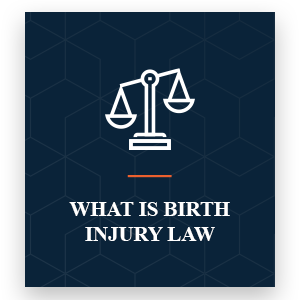
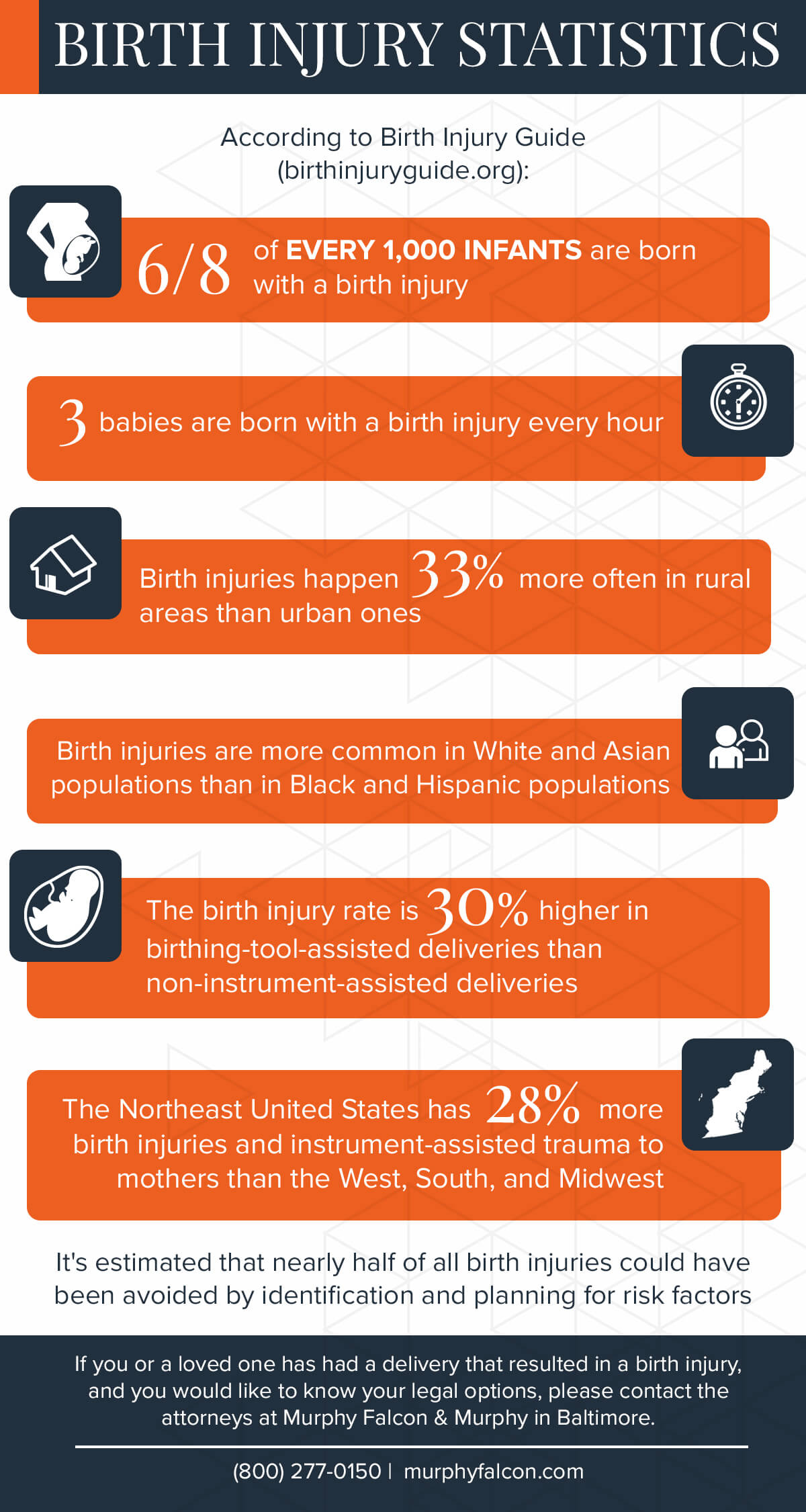
Medical Malpractice May Lead to Birth Injuries
Mothers trust their obstetricians and gynecologists to take proper care of them and their babies throughout pregnancy, labor, and delivery. When one of these physicians is negligent in his or her professional duties, it could cause serious birth injuries to the child.
Preventable birth injuries are typically caused by actions of medical malpractice including:
- Failure to provide adequate prenatal care including diagnosing and treating maternal conditions
- Failure to treat the mother for infections during pregnancy
- Failure to appropriately monitor vital signs during labor and delivery
- Failure to respond to cardiac complications during birth
- Failure to perform a medically advisable emergency cesarean section
- Misuse of birth-assisting tools including forceps and vacuum extractors
- Failure to detect and address problems with the umbilical cord
- Failure to treat conditions in the newborn such as meconium aspiration syndrome, jaundice, or infant respiratory distress syndrome
- Mismanagement of dystocia or breech deliveries
- Lack of labor preparedness and mismanagement of normal delivery procedure
- Failure to address and correct adverse effects from surgery or drugs, including anesthetic complications and epidural toxicity
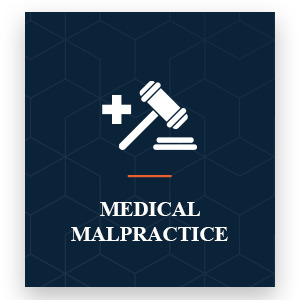
Brain Injuries and Related Neurological Condition
Bone Fractures and Nerve Damage
Bodily Injuries
Brain Injuries and Related Neurological Conditions
An injury to the brain at its early stages of development could lead to the following conditions:
Asphyxia
Oxygen deprivation, also known as asphyxia, is a condition where the body and the brain receive an insufficient amount of oxygen. Without oxygen, cells in the body will begin to malfunction, then die. Asphyxia can occur before, during, or after a baby’s birth, which can have long-term effects for the infant and their family.
Babies who survive asphyxia during pregnancy, labor, or delivery, are at a higher risk for mental complications. Even a mild lack of oxygen can cause a newborn to suffer from developmental delays and brain damage.

Brain Damage
Head and brain trauma during or after birth or injuries to the infant’s spinal cord could lead to temporary or permanent brain damage.
Traumatic and acquired head or brain injuries may impact an infant’s brain development and culminate in long-lasting physical or cognitive difficulties. Physicians may diagnose some brain injuries right away, while others could take months or years to detect. Either way, parents may have medical malpractice claims against at-fault physicians or healthcare centers. The moment a physician diagnoses your child with a brain injury or related condition, contact an attorney.

Cerebral Palsy
Cerebral palsy (CP) is a lifelong neurological condition that affects parts of the brain that control motor skills and coordination. It stems from abnormal brain development or brain damage sustained before the age of five. Congenital cerebral palsy, which according to the CDC affects the majority (85% - 90%) of CP patients, is related to brain damage that happened before or during birth.
Congenital cerebral palsy is most often associated with a lack of oxygen to the baby’s brain during labor and delivery, infections in the baby or mother, high blood pressure during delivery, complications with the placenta, or blunt force damage.
Risk factors for congenital cerebral palsy include:
- Low birth weight — babies who weigh less than 5.5 pounds at birth
- Preterm babies
- Twins, triplets, and other multiple births
- Infections during pregnancy or labor and delivery
- Jaundice and kernicterus
- Difficult labor or birth complications
It may take months or years for medical professionals to identify and diagnose CP in a child, and there is no cure yet available. In some cases, birth injuries that cause CP could have been prevented with adequate medical care.

Kernicterus-Related Brain Damage
Kernicterus is a rare form of preventable brain damage. It can happen in infants with severe jaundice: a condition in which the skin and whites of the eyes turn yellow due to high levels of bilirubin in the bloodstream.
Bilirubin is a bile chemical that is ordinarily removed from the body by the liver. During pregnancy, the mother’s liver performs this function, but after birth, the baby’s liver takes over. Some babies’ livers may not be developed enough to remove bilirubin efficiently, and when there is a buildup of the chemical in the bloodstream, the skin and eyes may take on a yellow hue. Jaundice is relatively common in newborns; about 60% of all babies have some level of jaundice, but risk factors for more severe jaundice include:
- Preterm babies — higher risk for underdeveloped liver function
- Babies with dark skin color — more difficult to see early symptoms of jaundice
- Babies of East Asian or Mediterranean heritage — higher bilirubin levels at birth
- Babies with eating difficulties in the first few days of life
- Babies who have a sibling who has had jaundice — higher genetic risk
- Babies with bruises at birth — healing large bruises can lead to high levels of bilirubin
- Babies with O blood type — higher bilirubin levels on average
Most hospitals have a policy in place for examining babies for jaundice before they are discharged, since failure to properly treat a buildup of bilirubin could result in its entering and permanently damaging the infant’s brain tissues. This kind of brain damage is called kernicterus, and it can result in hearing loss, vision problems, issues with tooth development, athetoid cerebral palsy, and, in some instances, intellectual disabilities.
Kernicterus can be prevented by early detection and appropriate management of jaundice.

Bone Fractures and Nerve Damage
Infants can suffer broken bones during or shortly after birth if the attending physician fails to use proper, prudent care when delivering the child. Improper birthing techniques, inadequate responses to emergencies, or misuse of tools such as forceps and vacuums could lead to bone fractures in the infant – particularly in the face, shoulder, clavicle, or arm — and these fractures may lead to related nerve damage that results in temporary or permanent paralysis.
Bone fractures and nerve damage sustained at birth could result in the following conditions:
Birth Fractures
Infant bones are more fragile than adult bones, and unfortunately, Birth Injury Guide reports that birth fractures are one of the most common kinds of birth injuries. Birth fractures can be minor or severe, and they are often sustained alongside nerve damage.
Birth fractures are most likely to be caused by:
- Dropping the baby
- Using too much force with birth-assisting tools like forceps
- Using too much force pulling the baby’s arm
- Failing to order a medically advisable emergency cesarean section
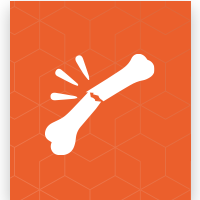
Brachial Plexus Injuries
The brachial plexus is the network of nerves between the shoulder and the neck, responsible for carrying signals between the brain, shoulders, arms, and hands. When the brachial plexus is torn, stretched, or compressed — which can happen during difficult births — the interruption of nerve signals may result in temporary or permanent paralysis in those areas.
Risk factors for brachial plexus injuries include:
- Shoulder dystocia — the baby’s shoulder is stuck behind the mother’s pelvis
- Narrow/small pelvis in the mother
- Larger than average birth size
- Diabetes in the mother
- Twins and other multiple birth deliveries
- Siblings with brachial plexus birth injuries
- Breech (feet-first) deliveries
- Need for birth-assisting tools like forceps
- Prolonged or difficult labor
Nerve conditions related to brachial plexus injuries include:
- Erb’s Palsy: Erb’s palsy accounts for 75% of all brachial plexus injuries. It affects the nerves that control arm movement. This means that a baby with Erb’s palsy typically has good motor control in the hands, but movement is inhibited in the arm itself.
- Horner’s Syndrome: Making up 10 to 20% of all brachial plexus injuries, Horner’s Syndrome is caused by rupturing the nerves that transmit signals to parts of the face, especially around the eyes.
- Klumpke’s Palsy: Klumpke’s palsy is a rarer type of brachial plexus injury which disrupts nerve communication to the wrists, fingers, and forearms.
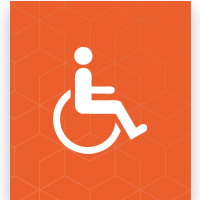
Congenital Facial Paralysis
Congenital facial paralysis is a condition of temporary or permanent damage to the infant’s facial nerves at birth. This kind of nerve damage can lead to facial paralysis, most commonly in the lower half of the face. Symptoms may not be immediately apparent, but if a baby has asymmetric facial expressions, little to no movement on one side of the face, or one eyelid that won’t close, they may have sustained facial nerve damage. Congenital facial paralysis may improve on its own, but in some cases it could result in permanent damage or require surgery.
Congenital facial paralysis is caused by too much pressure or force against the nerves of the face, and it is most often caused by:
- High pressures within the birth canal
- Improper use of forceps
- Impact injuries from being dropped

Spinal Cord Injuries
Difficult deliveries sometimes result in blunt force trauma to the infant’s spinal cord. As the body’s central communication system, the spinal cord is one of the most important parts of the body to protect, and damage sustained at birth may result in lifelong physical or mental disabilities.
Symptoms vary according to the type and severity of spinal cord damage. If you believe your child may have suffered a spinal cord injury during labor and delivery, it’s worth it to speak with an experienced birth injury attorney to determine possible at-fault parties and recover damages for surgery, therapy, or other medical treatment.

Other Bodily Injuries
Infants can also sustain physical injuries not related to bone fractures, brain damage, or nerve damage. In some cases, these types of injuries make complications more likely to occur.
Caput Succedaneum
Caput succedaneum is a condition in which an infant’s scalp swells due to pressures inflicted during labor and delivery. It is commonly caused by:
- Too little amniotic fluid in the womb or during delivery
- Misuse of vacuum extraction tools
- Premature rupture of the membranes that cushion the child’s scalp
- High birth weight or narrow maternal pelvis
Generally speaking, this condition is not serious and will go away on its own, but if not appropriately monitored, it may result in more severe complications such as jaundice and kernicterus.
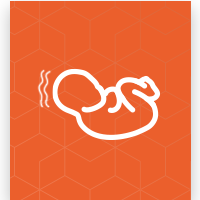
Cephalohematoma
A cephalohematoma occurs when a vein bursts and blood pools between an infant’s scalp and skull, creating a round lump on the head. This happens in 1 to 2% of all births, and although it is occasionally caused by natural birth processes, it may also result from malpractice such as misuse of forceps or vacuum extractors during difficult deliveries.
Although a cephalohematoma on its own is considered a minor injury that should go away on its own, it may be symptomatic of more serious injuries such as an infection or skull fracture, and it may lead to further complications or injury.

Subconjunctival Hemorrhage
Subconjunctival hemorrhages (also known as retinal hemorrhages) happen when small blood vessels around and underneath the eye rupture. This can happen to anyone of any age, but it is most common in infants born from difficult deliveries. The telling symptom is a red patch in the whites of the eye.
Like cephalohematomas, subconjunctival hemorrhages sometimes occur due to the natural pressure of the birth canal, but the risk of injury increases with use of forceps or vacuum extractors. In most cases, this type of injury will resolve itself, but left unmonitored it may lead to future complications with vision.

Wrongful Death
In the worst cases, medical malpractice during pregnancy, labor, and delivery may result in the wrongful death of an infant.
Murphy Falcon & Murphy’s team of wrongful death attorneys is here to help during difficult times. We can remove the legal burden from your shoulders by taking care of all the details, from reviewing your options with you to filing a claim and pursuing damages. If you would like to know more, please contact our office in Baltimore.
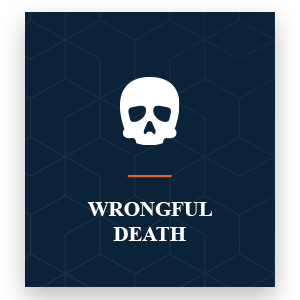
Causes of Birth Injuries
Notwithstanding unavoidable causes, numerous birth injuries are the result of medical malpractice. Parents are often given insufficient information regarding the cause of their child’s condition and can be wrongly led to believe that a preventable mistake was inevitable.
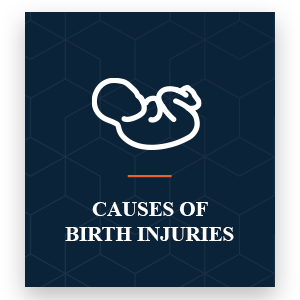
1
Dystocia
A type of obstructed labor that happens when, after the head is delivered, the shoulder has difficulty passing through. If doctors fail to properly respond to dystocia, the umbilical cord can become compressed and be life-threatening to the infant. Resulting complications from dystocia can include Klumpke paralysis, Erb’s palsy, and cerebral palsy, among others.
2
Fetal distress
A labor complication characterized by diminished oxygen to the infant. Prolonged diminished oxygen can result in permanent brain damage or death.
3
Prematurity
When doctors fail to respond appropriately to premature birth, an infant is at risk for problems like apnea, jaundice, respiratory distress syndrome, and others.
4
Prolonged labor
Extended labor (labor that lasts longer than 14-21 hours) can be labeled “failure to progress.” When this happens, the baby is at risk for serious complications.
5
Birth infections
Infections, if left untreated, can cause serious birth injuries such as brain damage. Some common infections include bacterial infections, rubella, and cytomegalovirus (CMV).
6
Improper use of force
during delivery
The use of forceps, ventouse, or excessive pulling during delivery can cause fractures and even paralysis.
7
Abnormal pelvis shape
Labor can fail to progress if the mother has an irregular pelvis structure. Doctors can note this ahead of time to plan for a safer delivery option, such as C-section.
8
Hypoxic ischemic encephalopathy (HIE)
This is a type of brain injury that often results from diminished oxygen to the infant during childbirth.
Even if you had a major risk factor present, your doctors and nurses are trained to remain vigilant and respond to your specific medical needs to ensure a healthy delivery. For example, the hospital staff is required to monitor your fetus’s condition closely in the days and hours leading up to delivery. If fetal distress is discovered or a condition becomes life-threatening, a responsible healthcare provider should take the necessary steps to keep you and your baby safe, including scheduling an emergency C-section.
Identifying a Birth Injury
Some physical injuries may heal fairly quickly after delivery, including minor bruising or forceps marks, swelling in the scalp, and other injuries. Although the initial injury may look very extreme, most heal within a few weeks of birth. If they do not heal within the first weeks of your child’s life, or you begin to notice developmental delays, you could have a more serious situation on your hands.
Physical injuries often require therapy or surgery, like the following movement-impairing conditions:
- Paralysis
- Fractures
- Shoulder dystocia
- Injuries to the brachial plexus
Cranial injuries, such as cerebral palsy or brain damage, are often the most life-altering injuries and usually occur when a child experiences hypoxic-ischemic encephalopathy (also known as hypoxia, or simply a lack of oxygen) during the delivery process. Early treatment for these injuries can include therapy, medication, surgery, or accessibility devices.
Ultimately, the treatment process is as wide-ranging and complex as the injury itself and will vary greatly for each individual. Consult with your physician immediately to determine the best course of action for treatment and prevention of further injury or disability.
Why and When Should You Hire an Attorney?
A birth injury is never something a parent should take lightly. Do not assume your doctors did everything they could and should have to prevent the injury. Do not think the injuries might have been your fault or that you don’t have the right to pursue financial compensation through legal means. Do not assume you’ve missed the deadline to file, even if years have passed since your child’s delivery.
The hospital or birth center will likely send an insurance representative to communicate with you about the birth injury event. Protect your family’s rights by entering into these conversations with legal representation. Without a lawyer’s help, you might accept a low-ball insurance settlement offer or end up with no compensation at all. You and your family deserve compensation for the exorbitant medical expenses of a birth injury, as well as justice for your child. Going up against a physician or hospital can shed light on a dangerous situation and potentially save other children from the same fate in the future.
Maryland Birth Injury Laws and Statutes
Like all types of injury cases, birth injury lawsuits follow state-specific statutes in Maryland. It’s important as a claimant to have at least a cursory understanding of the most important laws so that you know how and when to take legal action for your injured child. As always, you can contact our firm and we’ll answer your legal questions and concerns. In the meantime, here are two important state laws we believe all parents should know:
Who Can File a Birth Injury Lawsuit?
First, only certain parties can file. In the majority of cases, parents have the right to file a claim against one or more parties for birth injury medical malpractice. Parents will file a lawsuit on behalf of the injured child when the child is too young and/or mentally incompetent to legally bring the claim him/herself. Parents can claim recovery for their child’s damages as well as their own, including parental mental anguish and emotional distress.
What is the Time Limit for Filing
Second, there is a time limit for filing. There are time restraints you must obey for the Maryland courts to agree to hear your case. In general, the deadline that claimants have for filing a lawsuit is:
- five years from the date of the birth injury or
- three years from the date of discovery of the injury
For example, if doctors do not diagnose your child with cerebral palsy until the age of three, you would have three additional years to file a claim. In Baltimore wrongful death birth injury claims, you have three years from the date of death to file. In all cases, you must file a claim before the child’s 11th birthday.
Who Might the Courts Hold Liable?
Who could be liable (legally responsible) for your child’s injuries depends on the circumstances of the birth injury or accident. In many cases, doctors and surgeons are independent contractors and not employees of the hospital. If an independent contractor caused your child’s injuries, you might have grounds to sue the individual. If, however, the physician or worker is a hospital employee, the hospital or healthcare facility could be vicariously liable.
In other birth injury cases, third parties could have or share fault. For example, if a malfunctioning piece of medical equipment caused the injury, you might be able to bring a claim against the product manufacturer and/or the hospital for failing to maintain the equipment. There are many lawsuits in which there is more than one party at fault for injuries. It’s important to retain an attorney who can investigate your child’s injuries, identify all defendants, and go up against major healthcare facilities and insurance companies on you and your child’s behalf.
Murphy Falcon & Murphy knows that many birth injuries are preventable and stem from acts of negligence on the part of a doctor, nurse, or the birth center itself. Our firm has a 70-year history and an outstanding reputation within the Baltimore community. We are passionate about justice and can help hold those responsible for your child’s birth injury accountable. If you believe you have a birth injury case, contact our office today.
Contact a Baltimore Birth Injury Lawyer
At Murphy Falcon & Murphy, we treat all birth injury claims with a personal touch. We know that birth traumas deeply affect all those involved, but none more so than the parents. As a parent, you need a lawyer who cares as much about your case as you do. Our attorneys work hard to protect the rights of injured infants and their parents. We give voices to those who otherwise wouldn’t have them in a court of law.
Entrust your birth injury case to our attorneys to make the legal process as efficient and rewarding as possible in Baltimore. Call (410) 951-8744 or contact us online for more information.
